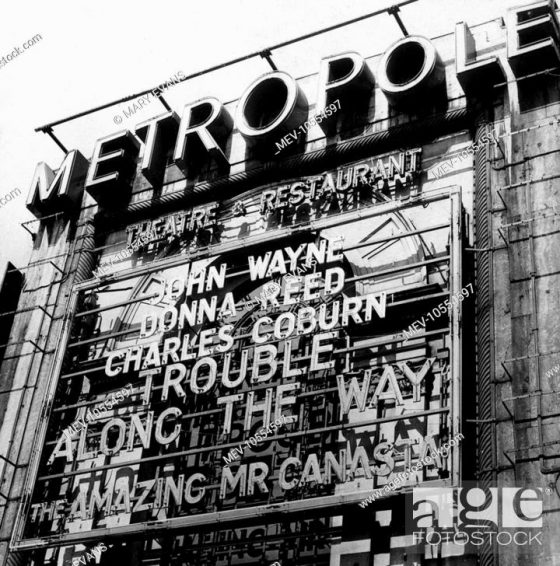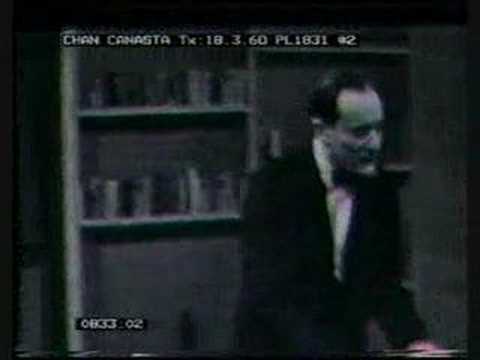Chan Canasta appeared on our Television screens very regularly throughout the 1950 s. I can’t remember much about him but I do remember the name and how famous he was at the time.
Butchers Film Service called him The Amazing Mr Canasta when they filmed him in a half-hour supporting short for the cinemas in 1952.

The title seems perfect – ‘The Amazing Mr Canasta’
He referred to himself as a mentalist but never a conjuror or magician.
Chan Canasta was one of those few sensations of the Fifties whose fame was made by the BBC the only television channel of the time.
The specialised arm of mentalism, where everything is in the master’s mind, was rarer. The audience would gasp with amazement
Chan Canasta was born Chananel Mifelew in 1920 in Krakow. His father was a Russian emigre, proud of his boy, who went to Krakow University at the age of 17.
He was Polish and Jewish and all of hi family perished in the Holocaust.
After studying philosophy and the natural sciences for a year, he left Poland for Jerusalem, where he started to study psychology. The next year brought the Second World War, and he volunteered for service in the Royal Air Force. He saw action in the Western Desert, North Africa, Greece and Italy, finally becoming a British subject.
Demobilised, he began seriously to study the science of extra-sensory perception. On the side he read up parlour magic and taught himself to entertain a few friends.
He developed the rare power of immediate photographic recall, which enabled him to do amazing things.
For instance he could instantly state the number of vowels on a page selected at random from a book by a volunteer from the audience, or to forecast accurately the sequence of playing cards in a suddenly shuffled deck.
Not every trick worked. Indeed, the occasional failure was actually encouraged by Chan Canasta, who believed his audiences enjoyed the suspense and reacted to the odd error as if it proved his magic was no trick.

BBC Television discovered Canasta in 1951. John Freeman hosted the half hour show. He was the editor of the New Statesman so , in a way, he gave the show the seriousness that would be required for a scientific experiment.
Quite a few well known guests were included on the show including Sylvia Peters

It seemed impossible that a man, even a professional mentalist, could transmit his thoughts through the television camera into the homes of a million or more viewers via their television screens – but this is what Canasta did – or seemed to do. With the use of what he called his “tube- destroying machine”, he said, he would use his power of thought to switch off every television set in the country which was tuned in to him. “Concentrate,” he told his audience, “concentrate.”
In homes across the country television screens went black with (the Fifties television trademark) the diminishing white spot that eventually popped off into nothing. Forty suspenseful seconds passed before the screen leaped back into life, showing a smiling but apologetic Canasta admitting that his stunt was “only a leg-pull!” He then showed how one of his cameras was trained on a screen in the studio, which was suddenly switched off, then on again. The audience applauded but not so the angry viewers, who rang the BBC under the impression that Canasta had ruined their sets.
Chan Canasta became something of an international celebrity. American television welcomed him, and he appeared on such programmes as those hosted by Ed Sullivan and Jack Paar. He shot to the top of the bill at the London Palladium, and echoed this triumph far away at the famous Desert Inn in Las Vegas.
In 1962 he returned to London to star for the new commercial television station Associated-Rediffusion. Dan Farson hosted these late-night half- hours, which again featured guest personalities and a small but fascinated audience. Humphrey Lyttelton, the jazz man, remarked: “The man is a phenomenon.” Farson said: “Canasta has a fantastic command of psychology.”
In his television career, Chan Canasta performed in some 350 programmes. He gave his last one in 1971 as a personal favour to Michael Parkinson. By this time he had taken up a new sideline as a painter, with successful selling shows in London and New York. He signed his pictures “Mifelew”, his real name. But it is as a perfectionist performer that millions will remember him.
“I want to prove that nothing I do is phoney ” he added
Chan Canasta was married twice – later in his life, he was with Maureen Endfield the widow of the film director Cy Endfield, possibly she was his second wife, I am not sure.
Of course we all remember Cy Endfield as the Director of ‘Zulu’ one of the biggest grossing British Films
Hi,
Many thanks for this article, about one of my true heroes of Mentalism – Chan Canasta.
Just an additional point that you may not be aware of. Cy Endfield was an extremely accomplished Card Magician. He created a number of original moves (sleights) and Card Magic routines, that were unique within the Art of Magic.
Cy primarily performed his craft for fellow Magicians, rather than performing shows for audiences – no doubt his film work took up the majority of his time.
Cy’s work is recorded in a series of 3 books – ‘Cy Endfield’s Entertaining Card Magic’; written by Magician/Author Lewis Ganson, during the 1950’s. More information can be found here:
https://www.lybrary.com/cy-endfields-entertaining-card-magic-p-84566.html
Kind regards,
Barry Allen
(Mind Reader & Palmist)
HI,nice article about Canasta.
I was wondering, aren’t there any other videos available? Not even those from his appearances on American TV? I tried searching for them on archive.org without success. It would be a great thing to see other Canasta’s book test performances.
Thanks in advance!
Mauro Rapinesi
… [Trackback]
[…] There you will find 32492 additional Information on that Topic: filmsofthefifties.com/television-through-the-fifties-chan-canasta/ […]